Princeton Campus
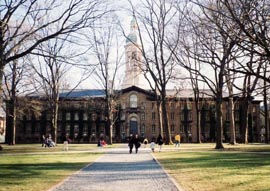
|
Nassau Hall (top) and the
commencement ceremony of
1961
|
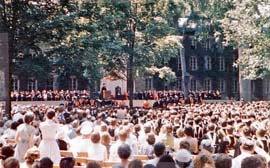
|
- Nassau Hall. Princeton's
protocol requires that this building be placed first in
every Princeton photo collection. This main administration
building was once George Washington's capitol of the
United States. A fierce combat took place in and around this
building during the Independence War.
- Nassau Hall viewed from a different angle.
- Nassau Hall after light snow
(January 2009).
- Two Tigers at the entrance to the Hall.
- Two Tigers and a rear view of
Nassau Hall. Tigers and humans.
- Two Tigers seen from the
Nassau Hall.
- Putnam Sculpture and a side view
of Nassau Hall.
- Commencement of 1961 in front of
Nassau Hall. I was there.
- Did you know
Princeton was once the capital city of the United States? The Nassau
served as George Washington's government building.
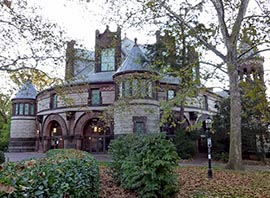
|
|
Historic Alexander Hall
|
- Alexander Hall. This building has a
complicated history, but it is clear that many important meetings
were held in the auditorium of this building.
- Back of Alexander Hall. Many
exciting events take place here.
- John Witherspoon (1723-1794). He came
from Scotland and became the 6th president of Princeton University in 1768.
Witherspoon was the first president who knew how to build a college of the
form known today. He invented the word campus. He was a
Presbyterian minister and was a strict moralist. Thanks to him,
my PhD diploma of 1961 says "This person is morally perfect!"
Pyne Hall is in the background. This old
building is used for many different purposes, including the comptroller's
office, student meeting rooms, cafeterias, etc.
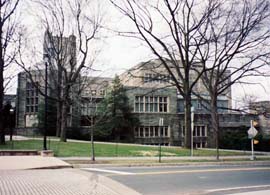
|
Firestone Library seen from Washington Raod
Prospect Garden Fountain
|
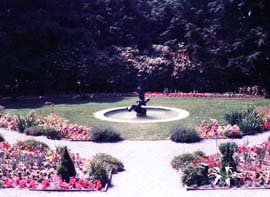
|
- Firestone Library. This building is
also Princeton's landmark. In addition to a study place for students,
the library contains many books and documents of historical
importance.
- View from Washington Road.
- View from Nassau Street.
- Seeley G. Mudd Manuscript Library
contains many inportant manuscripts, including PhD dessertations.
Let us look at
- View from the opposite direction.
- Entrance. This climatic-controlled
building has its entrance. You can go in and ask for a xerox coy of
Feynman's PhD thesis.
- Feynman's Thesis.
Selected pages available from the University Archives, Department of
Rare Books and Special Collections, Princeton University Library.
Courtesy of Princeton University Library.
- Prospect Garden used to be the
presidential mansion located at the center of the Campus. It is now
used for a faculty club.
- Another View of
the Prospect Garden.
- Fountain at the Garden.
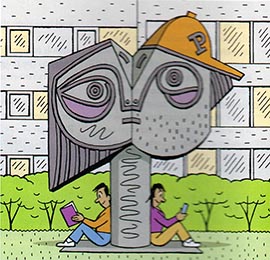
|
|
Picasso's image of a woman stretched (copied from the PU Alumni Weekly)
|
|
- Art Museum has a very respectable
collection of art works. I once asked the museum director how he got
those expensive items. He said Princeton has many rich alumni.
- Picasso Sculpture
used to be in front of the Art Museum. This art piece called the
"Head of a Woman" was constructed by a Norwegian artist Carl Nesjar in 1971
under the supervision of Pablo Picasso. This sculpture has been moved to a
corner of the campus near the railroad station. The campus made a mistake.
- Extension of Picasso's Imagination.
The Princeton Alumni Weekly in its issue of April 6 (2011) carried
this drawing of the Picasso woman. It related the woman's face with
book pages.
- Joseph and General's Wife. I heard the
story of Joseph in Egypt from my grandmother when I was 9 years old. I still
remember her expression when she was talking about how Joseph was arrested.
She had to skip the details because she knew I was too young to understand
what a woman can do to a man.
- Greek jar in the Greek section.
- A statue in the Indian section.
- Roman floor in the Roman section.
- Items in the Egyptian section
- Goerge Washington and
Marilyn Monroe in the American room.
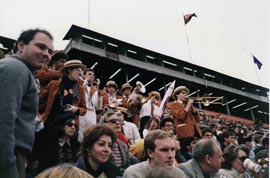
|
|
A tense moment in the Stadium
|
- Palmer Stadium. Princeton's Football
Stadium
- Jadwin Gymnasium.
- DeNuzio Pool. Princeton's
Swimming Pool.
- Lake Carnegie. This lake is relatively
narrow but long, and it is ideal for canoe race (1983). This lake is between
the campus and the US Route 1.
Lake Carnegie during the winter time (1960).
Frozen Lake (1960).
Lake Carnegie on Sunday morning (2007).
- McCosh Health Center. If you become
tired and exhausted, you can spend one, two, or even three nights here under
nurse's care. I spent three nights here in 1961. I was 25 years old, and
the nurse was about 50 years old (like my mother). It was like home.
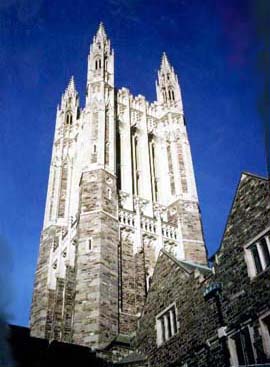
|
|
Cleveland Tower of the Graduate College
|
|
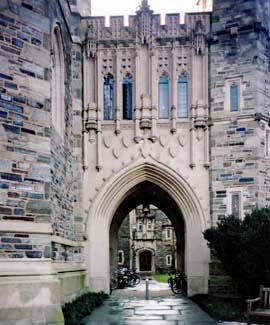
|
|
Entrance to Graduate College Quadrangle
|
|
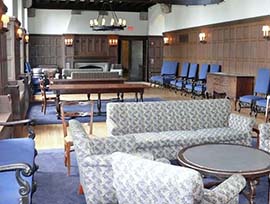
|
The Commons Room of the
Graduate College
|
|
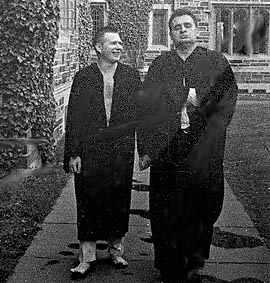
|
Piere Sabatier (right) in gown.
The other person is also in gown
but is bare-footed.
|
- Graduate College (1961, 2000, 2008).
In 2008. I went to the Graduate
Collge in 1958 for the first time. Fifty years later, in 2008, I went
there again. Every thing seemed to be the same, but there was one
difference. There are now female students. Princeton used to be an
all-male univerity.
The Graduate College has a history. When Woodrow Wilson was the president
of the University, he was interested in building the Graduate College
building at the center of the campus, perhaps near the Prospect
Garden. The College was to include residence halls for graduate students.
However, the rest of the University was against his
idea. At that time, the concept of graduate education did not
sound exciting to the University community. Eventually the
College was built
at a location about one km away from the center of the campus.
Woodrow Wilson was so upset that he had to seek a new position.
He became the governor of New Jersey, and then the president of
the United States. Let us look at a photo of
- Woodrow Wilson in
Versailles with Raymond Poincare, the president of France (1920).
- Cleveland Tower at the Graduate
College.
- Graduate College Commons Room,
where many things happen.
- Bicycles parked at the Graduate
College quadrangle.
Since classes are held in the main campus (1 km away from the
College), graduate students need transportation.
- Proctor Hall has been and
still is the main dining hall of the Graduate College. When I
was a student (1958-61), we had to wear black academic gowns, but
I did not like the gown.
- Pierre Sabatier was an exchange student
from France loved to be formal (1958-59). In this photo, he (tall man)
is wearing the gown in preparation for the Proctor-Hall dinner. As in
this photo, he used to insist on French way of living. I
like to know who the other person in the photo was (photo courtesy of
Dieter Brill). Like to see Sabatier's
recent photo?
another photo! He is now an important person
at the Univ. of Montpelier in France, and likes to worry about the
physics of waves.
- I was also wearing the gown. I am the
tallest person in this photo.
- Princeton Inn seen from the
Graduate College ground. It used to be a very expensive hotel, but it is
now used as an undergraduate dormitory called Forbes College.
- Marriage Penalty. Married students
live in this village called "Butler Barracks." These temporary
buildings were built in 1945 for WWII veterans, and
the streets in this village are named after the famous
generals such as Eisenhower and Patton. The University later took
over these barracks to accommodate married graduate students.
These barracks are now more than 60 years old, but they still
play an essential role in Princeton's graduate education. They keep saying
these barracks will be replaced by luxury apartments soon, but they were
still there in January of 2011.
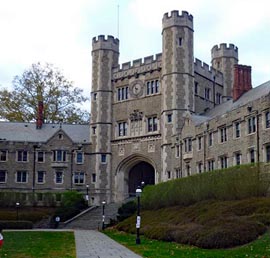
|
|
Blair Hall and Blair Beach
|
- Dormitories The campus of Princeton
University largely consists of undergraduate dormitories. Dormitory buildings
constructed in recent years.
- Blair Hall Blair Beach Dorms.
- Princeton Inn used to be an expensive hotel
across the golf course from the Graduate College. It is now one of the
undergraduate colleges called "Forbes College."
- Wilcox Hall. One of the undergraduate
dining halls. This building was completed in 1961 with a gift from
the Wilcox estate. Ferdinand Wilcox was from the Class of 1900, and
died in 1958.
- Chefs making omelettes for Sunday brunch.
- Students enjoying a late brunch. There
were no girls on campus when I was a student (1958-61). The Wilcox
Hall was for meetings of campus groups.
- Eating Clubs on Prospect Avenue.
- Prospect Avenue after light snow.
- Woodrow Wilson School of Public and International Affairs.
This building was constructed while I was a graduate student (1958-61). The style was
controversial because its appearance is quite different from those of other buildings
of the University. The construction was funded by the Rockefeller Foundation, a
financial giant at that time.
- Wilson's Bust in the main lobby of the
building. I had a photo with him in 2013.
- Syngman Rhee was Wilson's student, and he
received his PhD degree in 1910. He became the founding president of
Korea in 1948 and started building his country modeled after the
United States under many difficult conditions, including three years of
the Korean War (1950-53). It is very safe to say that Rhee was Wilson's
most accomplished student. The main lecture hall of this School is now
called "Syngman Rhee Lecture Hall." I had a
photo of myself there.
This is Rhee's photo with Harry Truman
taken at
Truman's home in Missouri (1954).
- Adlai Stevenson
was also a distinguished Princeton graduate. With my camera in 1961,
I took a
photo of Stevenson who came to his 50th alumni reunion. He was
the ambassador to the United Nations. I was very happy to have
a photo of myself with Stevenson's bust
in the main lobby of this building in 2013.
- Future Secretary of State. This undergraduate student
was studying the world during the winter break (January 2002).
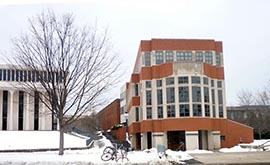
|
Department of Economics(top),
Engineering School.
|
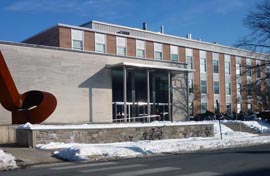
|
- The Department of Economics is next to
the Wilson School. Here is another view of this
Econ building. As this department is mentioned often in the media,
many young people come to study economics. Their ultimate aim is the
Nobel prize in economics.
When I was a student, everybody had to be a physicist. These days,
everybody has to be a banker. Princeton seems to set the trend.
- Entrance to the Engineering Quadrangle.
I was inside this quadrangle sometime ago, but not in recent years with my
camera. I hope in the future to take some photos inside this quadrangle.
I am particularly interested in their chemical and electrical engineering
programs.
- Department of Computer Science. Princeton has
a very strong computer science program in the tradition of John von Neumann.
Here is a
photo taken from a different direction.
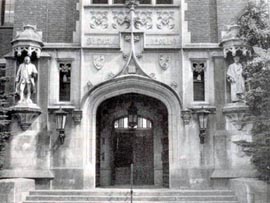
|
|
Entrance to Palmer Lab.
|
|
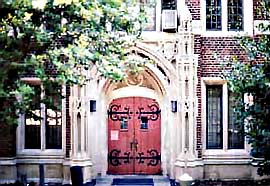
|
Entrance to (old) Fine Hall
(now called Brown Hall)
|
- Palmer Physical Laboratory.
The first physics building, where Feynman and Weinberg studied.
I was old enough to studied here. Photo courtesy of the Princeton
University Library.
- Front of the Palmer Lab.
Incoming graduate students of 1968.
- Old Photo of Palmer Laboratory,
a postcard from Pat Klein through eBay.
- Another Old Photo, from
Dada Mecantile (Pioneer, California).
- Fine Hall was next to Palmer Lab.
This building was for the mathematics department, but Wigner's office was
there. The physics library was also there. I spent more time in the
Fine Hall library than in Palmer Lab. I used to take naps there when
I was tired. Indeed, the Fine Hall Library was my Princeton address.
This building is now called Brown Hall.
- Palmer Lab became the
"Frist Campus Center" and the "Center for Asian Studies." When I
was a student (1958-61), I was a very unusual student because of
my Asian origin. Times have changed.
- Jadwin Hall. The physics
programs are housed in Jadwin Hall. This is a photo of
the Jadwin quadrangle.
- Jadwin Hall Entrance. Two young
physicists in front of the entrance.
- Cosmic Ray Laboratory.
This building, now called the Elementary Particles Lab, was
built as a temporary building during the WW-II period. This
is one of the permanent temporary buildings on the campus. My
physics career started from this building.
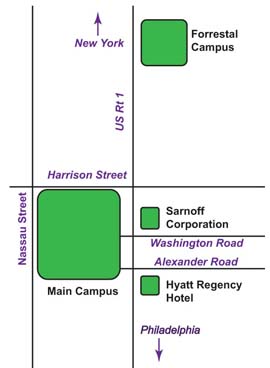
|
|
Forrestal Campus of Princeton
|
- The James Forrestal Campus of Princeton
is about 10 km away from the main campus. This place has a very interesting history,
but I still do not know whether it is legal to take photos of this place or post them
on webpages. This research center was constructed originally for fusion research.
-
Project Matterhorn. Encouraged by the success of the hydrogen bomb
in 1952, American scientists initiated a program to develop controlled fusion for
generating clean energy using only hydrogen isotops. This project was heavily
funded by the U.S. government. I remember seeing two huge energy-storing flywheels.
The idea was to release the energy in a very short period of time to create high
enough temperature to trigger a thermo-nuclear reaction. This was one of the ideas
which did not work. Yet, they tried every possible method for more than 30 years.
- PPPL. These days, the main function
of this Forrestal campus is the Princeton Plasma Physics Laboratory, still heavily
funded by the U.S.government. It serves as the world headquarters of plasma
physics.
-
PPPL Offers Twice-Monthly Public Tours.
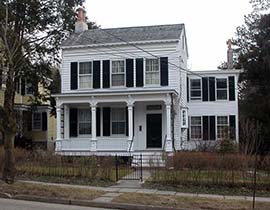
|
Einstein's House, and
his photo with Irina Joliet-Curie
|
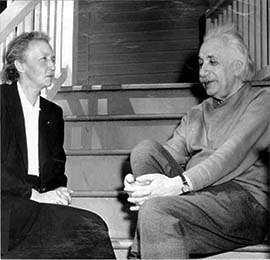
|
- How did Einstein come to Princeton?
-
Einstein lived in this house at 112 Mercer Street.
- He walked to his office in the morning
along this route.
- His office was in the Fuld Hall of
the Institute for Advanced Study. Here is
another view of
this building.
- Back of the Fuld Hall.
- You are invited to
my website dedicated to Einstein.
- Einstein's Abel and Cain.
He did meet too many people while in Princeton. Among the people
he met, he liked some and disliked others.
- John von Nuemann was also
a permanent member of the Institute.
- Library. I am with an Italian history
professor from Naples. The Institute is known for its physics and
mathematical programs. Equally strong is its history program.
- Westminster Choir College. This is a
music college in Princeton.
- Main Building of the Choir College.
- Christmas Morning at Einstein's House.
The student choir of this college used sing Christmas carols in front
of Einstein's house to tell Einstein the Christ has come.
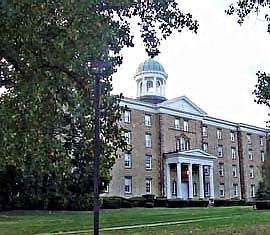
|
|
Brown Hall of Princeton Theological Seminary
|
- Princeton Theological Seminary
is one of the most Prestigious Presbyterian seminaries in the world.
This building, called Brown Hall, is most visible from College Road
linking the Graduate College of the University and the main campus
of the University.
- Alexander Hall is another
- Modern-style residence halls.
- Miller Chapel is a very
important place of worship for the future Christian leaders studying
at the Seminary.
- Main Library. This Seminary
is at the level of graduate school, and is a research institution.
- Templeton Hall is the main
administrative building of the Seminary.
- MacKay Campus Center where
student activities take place.
- Apartment Building for
visitors from foreign lands.
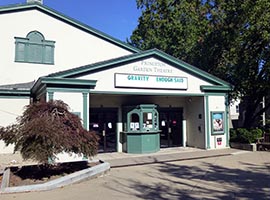
|
|
Princeton Garden is the only movie house in Princeton
|
- Princeton Garden.
This was one of the two movie theaters operating
when I was a student. This photo was taken in 2013.
- I watched Melina Mercurie's
Never on Sunday here in 1960.
- Forty two years later, on
January 11 (2002), I was standing next to the box office, and
invited to pose with me a gentle lady passing by. She sensed
that I am a Princeton graduate and told me it was her first time
to be held by a Princeton boy. I like to meet her again.
- I was there after a snow storm.
I could not tell when this photo was taken.
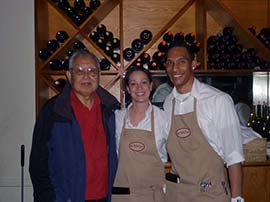
|
|
Wine bottles at the Mediterra
Photo from Kazan
|

|
- Princeton Play House. The other
movie theater was called "Princeton Playhouse" on Hulfish Street
behind the Nassau Inn. At this location, there is now an
Italian restaurant called "Mediterra."
- In 1960, in this
movie house, I watched a Soviet film entitled "Cranes are
flinging." A Soviet actress named "Tatyana Samoilova"
starred in this film. I have
a story to tell about this Russian lady.
- I also watched the Ivan the Terrible, Volume I and Volume II,
produced by
Sergei Eisenstein. These movies were so different from American
cinemas that I did some research on Eisenstein.
Click here for a story.
Indeed, Eisensteinn's original idea became the guiding principle
for my wegpages. Click here
for a story.
- Volume I of the Ivan the Terrible tells about the Volga city
of Kazan. When I made my first visit to Kazan in 1999, Russians
there asked me when I first heard about their city. I then
aanswered "Ivan the Terrible." They laughed. Here is
my webpage dedicated to Kazan
- Campus Railroad Terminal. It takes
ten minutes to reach Princeton Junction from this small campus station.
This building seems to be empty these days, as the railroad became less
important.
- Princeton Junction. The railroad
station on the other side of the US-1.
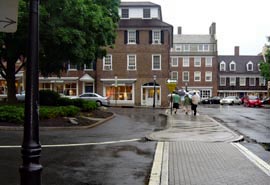
|
|
Stores around Palmer Square
|
- Palmer Square and Princeton Tiger.
They seem to worship the Tiger in Princeton. This Square on Nassau Streent
is on the opposite side of Alexander Hall.
- viewed from the west side from the
Square.
- viewed from the east side.
- Palmer Square Shops on north side.
- Visitors from France resting on a bench
on Nassau Street (2008). They came fron Nice on Cote d'Azur. Their boy is
interested in coming to Princeton for his college education. It was very easy
to talk to them because
I was at their place twice.
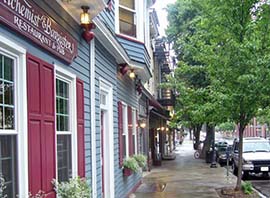
|
|
Shops on Witherspoon Street
|
|
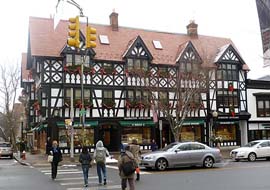
|
|
Hamilton Jewelers on Nassau Street
|
- U Store,
Princeton University Store. Like to buy
Princeton things from this
store?
- Entrance to U Store at University Place.
- Nassau Street Stores. Most of
the U-Store transactions are now handled by designated retailers on
Nassau Street.
- Shops on Witherspoon Street. There
are also good restaurants.
- Shops on Chamber Street. Princeton
needs some exclusive stores.
- Princeton Shopping Center. Resting Place.
- Hamilton Jewelers, located at the
center of town (across Nassau Street from Nassau Hall). This
European-style building tells Princeton was a place for rich
people. It was Woodrow Wilson who strengthened Princeton's
academic programs. Among the many reforms he introduced, Wilson
developed the graduate school which was initiated one year before
he became the president of the University (1902-1910). Yet, Princeton
still could not completely shake off its reputations as an
exclusive university for sons and daughters of rich and famous people.
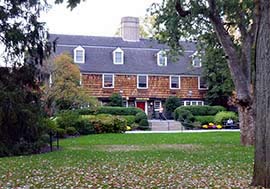
|
|
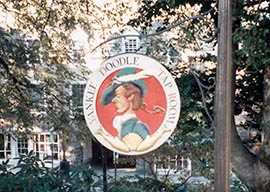
|
|
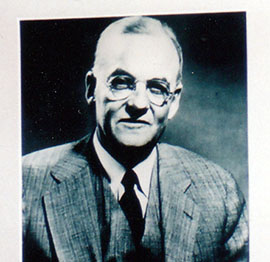
|
John Foster Dulles (top)
and Michell Obama
|
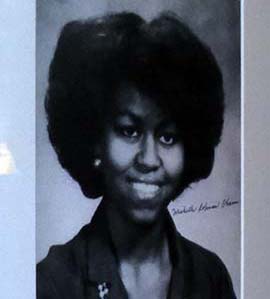
|
|

|
- Nassau Inn I stayed
in this hotel in 1991. I stayed there
again in September of 2013. The Inn looked
like this in 2013.
On the west side of this hotel is the entrance to the
Yankee Doodle Tap and Restaurant.
The Yankee Doodle Tap is a drinking room
directly accessible from the hotel registration lobby on the east side.
On the walls of this room, there are portraits of many famous
Princeton graduates, including
- James Forrestal was the first
secretary of defense when the department was created in 1947.
During World War II, there were several independent departments
performing war duties, including the depts. of war, army and navy.
These agencies became combined into one department. Princeton's
Forrestal Campus is named after him. It is believed that the
Forrestal Research Center carried out
the basic fusion research leading to the hydrogen bomb.
- John Foster Dulles, Secretary of
State (1953-59). Here is a
webpage dedicated to him.
- Adlai Stevenson, who ran against
Dwight Eisenhower in 1952 and again in 1956. He was the ambassador to
the United Nations during the Kennedy administration, covering the
Cuban missile crisis of 1962. He served his country well.
His bust is in the main lobby of
the Woodrow Wilson School for public affairs.
- Michelle Obama is of course the First
Lady of the United States.
- James Baker served as the secretary
of the treasury for Ronald Reagan (1985-88), and the secretary of state
for George H. Bush (1989-92). He also served his country well.
- Ralph Nader. His name is also
familiar to us. He is a very strong consumer advocate. He once attempted
to run for the president, but did not do too well.
Here is the
Wikipedia page for him.
- Brooke Shields, while a student
at Princeton (1983-84), was the most beautiful American girl.
Click here
her photos I took on her graduation day in 1987.
- There are many more photos, and I hope to post them when I have time.
This hotel used to be and still is a good place to meet the girls
from rich and famous families. There are many party rooms and
sit-down places in the building including the Yankee Doodle
Restaurant.
When I was a graduate student (1958-61), I was afraid of
those girls. I think these days I am established enough to talk to
them and have photos with them. Let me show you some photos taken
in 2013.
- These ladies are from Seattle.
They came to see their brothers and sisters studying in
Princeton. I proposed photos with them.
Many people hold their wedding parties at this hotel. Girls
dress up nicely for these occasions.
- These girls are in the bridal party.
I was very happy to have a photo with them. They made me
to think about my student days more than 50 years earlier.
- These ladies came to their
friend's wedding party. They were very happy to have a photo
with a Princeton boy.
There used to be a restaurant called
Green House Restaurant adjacent to the Nassau Inn. It is now a
Swiss chocolate store.
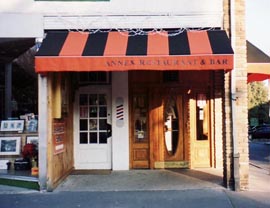
|
|
Princeton's Annex Restaurant on Nassau Street
|
|
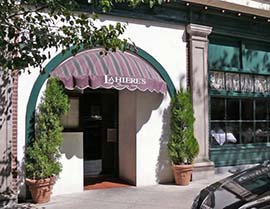
|
|
|
|
Lahere's French restaurant on Withersoon Street
|
- Annex Restaurant. Moderately
priced place on Nassau Street. I used to go there very often.
- Paul A, M. Dirac,
at this restaurant, met Wigner's sister who later became his wife.
- This place is now an Italian
restaurant called "Sotto." The barber shop is still there.
- La Hiere's French Restaurant on
Witherspoon Street. It was an expensive place. I used to go there
occasionally when I was a student. Einstein used to go there before
my time. I was there again in 2008 and has
this photo of myself standing next to Einstein's photo. This
landmark restaurant was closed in 2010, after 91 years of operation.
- Mediterra Restaurant is on Hulfish Street
behind the Nassau Inn. This is a decent Italian-American place, expensive
but affordable. At this location, there is an movie theater was called
"Princeton Playhouse" showing many movies of historical significance.
- Witherspoon Grill on Witherspoon
Street is also a restaurant which did not exist when I was a
student (1958-61).
- Princetonian Diner is a moderately
priced diner on US-1. I used go there often with my friends when
I was a student.
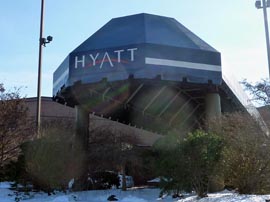
|
Hyatt Regency Hotel (entrance),
and its dining area
|
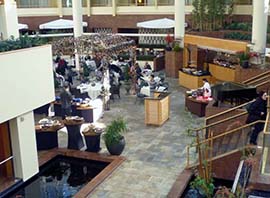
|
- Hyatt Regency Hotel accommodates
many visitors to Princeton. It has elegant lobbies and dining
places. This hotel hosts many international conferences.
- The entrance to the hotel looks like this.
- The Dining Area with tropical
environment.
- Fish Ponds enhance the environment
of the main lobby and the dining area.
- Many Interesting People. I meet many
interesting people in this hotel. These three young ladies are from
the Princeton area. I asked them why they are staying in this hotel while
their homes are so close. They said the hotel has an excellent swimming
pool. They were staying there in order to swim.
intersection of Alexander Road and US-1. This hotel
is relatively new, and did not exist when I was a student.
I meet my friends and colleagues at the restaurant in
this hotel. Actress Brooke Shields used to come here with her
mother.
- I usually stay in this hotel
when I go to Princeton with my wife.
- Birthday Parties. There are many birthday
parties held in this hotel. In 2004, I gave my wife her birthday party in
this hotel, but I did not invite anyone else. As for party decorations,
I used a balloon left over from someone else's birthday party.
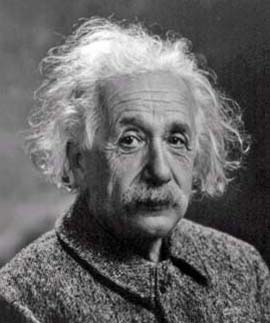
|
|
Photo by Orren Jack Turner (1947)
|
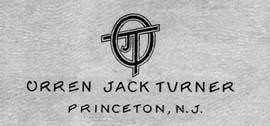
|
- Orren Jack Turner Photo Studio. Orren
Jack Turner (1920-2008) was an American soldier during World War II. After the
war, he inherited his father's photo studio on Nassau Street. The studio was on
the second floor of this gray building directly
across the street from Nassau Hall. His father opened this studio in 1909 and
started taking photos of Princeton's football games.
- In 1947, he produced this
photo of Albert Einstein, and used to own its copyright. He then donated
his copyright to the U.S. Library of Congress. This photo is now in the
public domain.
- In 1961, Orren Jack Turner
photographed me the day before by commencement. In this photo, I am with
my father.
- In 1959, my mother sent me
a Canon camera, and I started taking photos. I am not a professional
photographer, but I seem to know how to combine them to produce abstract
concepts. For instance, I produced
my own concept of the Garden of Eden.
- Einstein's House. I am standing in
front of the house in which Einstein lived until 1955.
- P-rade. Parade of Princeton Alumni.
Annual Event. Affluent Society!
- Einstein Magazine tells more
about Einstein.
In addition to the University, Princeton hosts many interesting research and
commercial organizations.

|
|
Sarnoff Corporation
|
- Sarnoff Corporation. On
the east side of the US-1,
there is the campus of Sarnoff Corporation. It used to be the David
Sarnoff Research Laboratory of RCA (Radio Corporation of America).
RCA disappeared, but Sarnoff did not.
- Campus
of Sarnoff Corporation.
- David Sarnoff
converted Maxwell's equations into electronic industry.
- Dow Jones Co. is about 10 km from
Sarnoff Co. This company is known to produce a four-digit number
everyday telling how American companies are doing. This is a big
company with a large number of researchers.
- Tight Security. I was not able
to enter the campus. I did not have security credentials.
- Otsuko is a Japanese pharmaceutical
company. The company's North American operational base is just next to
the Hyatt hotel.
- Another View of this huge building.
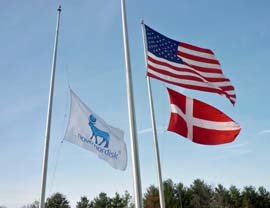
|
|
Nordisk Corporation in Princeton
|
|
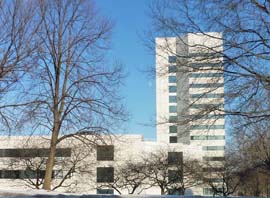
|
|
Johnson and Johnson in New Brunswick
|
- Novo Nordisk is a Danish pharmaceutical
company, and its American headquarter is near Princeton's Forrestal campus.
- Flags. The company is proud of
its Danish origin.
- Johnson and Johnson is one of the
giant health-care companies, and its headquarters is in
New Brunswick about 50 km north from Princeton. In the area between
these two citites, there are dozens of J & J establishments. I could not
go to all of them to take photos, but their New Brunswick base seems to
be very important.
- Rutgers. To us, New Brunswick is
known as the home of Rutgers University. The Johnson and Johnson
headquarters is right next to the main building (where the president's
office is ) of Rutgers.
- J&J Research Center next to the
company headquarters.
- Another J&J Building. This
tall building serves as the landmark of New Brunswick.
- New York City is only
60 kilometers away from Princeton. It takes one hour to go to New York by
train or bus. I used to go there very often.
|